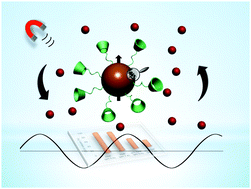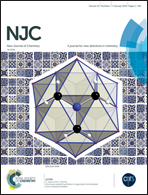AMF-responsive doxorubicin loaded β-cyclodextrin-decorated superparamagnetic nanoparticles†
Abstract
An alternating magnetic field (AMF)-responsive controlled release system has been developed by the binding of mono-6-deoxy-6-(p-tolylsulfonyl)-β-cyclodextrin (βCD-Ts) onto amine-modified superparamagnetic iron oxide nanoparticles (MNP-NH2), resulting in a MNP-βCD nanocarrier. The structural, chemical and colloidal properties of the nanocarrier MNP-βCD were fully evaluated by several techniques. Doxorubicin hydrochloride (DOX), as a model anticancer drug, was loaded onto MNP-βCD resulting in MNP-βCD-DOX and the release process was investigated by varying the temperature (37 and 45 °C), pH (7.4 and 5.0) and presence of an AMF (with and without). DOX can interact with the negatively charged surface of MNP-βCD and also with the cavity of βCD forming inclusion complexes. Under acidic conditions, both the negatively charged surface of MNP-βCD and the ionizable groups of DOX are protonated and the interactions between DOX and the nanocarrier MNP-βCD are weakened, thus, accelerating drug release. Temperature increase can reduce the supramolecular interactions between DOX and the nanocarrier MNP-βCD, favoring DOX release. Thermo-induced burst release at 45 °C has been investigated either by applying an alternating magnetic field (AMF, f = 307 kHz) or heating the solution in a thermostatic cuvette holder. In the absence of an AMF at 45 °C and at the pH value of the lysosome (5.0), 92% of DOX was released into the solution within 6 h. Importantly, in an AMF, at 45 (±1) °C and pH = 5.0, the same percentage of DOX release was observed after 50 min. Furthermore, in vitro assays revealed that the unloaded MNP-βCD nanoparticles (100 μg mL−1) displayed negligible cytotoxicity against A549 human lung adenocarcinoma cells either in the absence or presence of an AMF (H × f = 4.9 × 109 A m−1 s−1) applied for 30 min on the cells. In the presence of an AMF no macroscopic temperature variation was detected in the wells containing the cells incubated with DOX unloaded MNP-βCD nanoparticles. The same amount of DOX loaded nanoparticles (MNP-βCD-DOX) showed cytotoxicity only in the presence of an AMF (H × f = 4.9 × 109 A m−1 s−1 applied for 30 min), inducing cell death. Also, no macroscopic temperature variation was detected; therefore, DOX release might be associated with local heating generated from the rotation movements of the nanoparticles (Brown relaxation) upon AMF application. Thus, the DOX loaded β-cyclodextrin-decorated superparamagnetic nanoparticles (MNP-βCD-DOX) are a potential controlled drug release agent with cancer-killing properties under an AMF.



 Please wait while we load your content...
Please wait while we load your content...